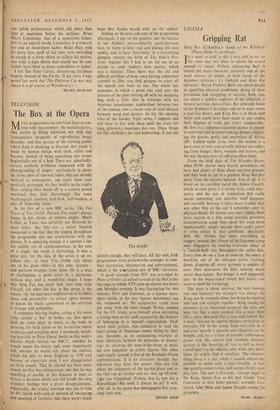CINEMA
Gripping Rat
King Rat. (Columbia.)--Sands of the Kalahari. (Plaza.) Both `A' certificate.
IN a week as cold as this it was odd to see on the same day two films in which the screen seemed to sweat. Pitiless, exhausting heat is almost the main character, certainly one of the main movers of events, in both Sands of the Kalahari (director: Cy Enfield) and King Rat (director: Bryan Forbes). Both are about people in appalling physical conditions, dying of their privations and struggling to survive; both, too, are about a ruthless exploiter of the situation, a natural survivor, hero-villain. But although Sands of the Kalahari is in colour and set in what seems a real live desert, and King Rat is in black and white and could have been made in any studio, their degrees of truth just aren't comparable: the first is a tuppence-coloured glance at people in contrived and fictional-looking danger, exploit- ing the glories, perils and enormities of Africa (Mr. Enfield made Zulu, too); the second is a hard stare at men you actually believe are suffer- ing from hunger, thirst, wounds and terrors, and the way the pressures of suffering affect them.
From the bluff days of The Wooden Horse, when POW stories were boyish adventures, we have had plenty of films about wartime, prisons, and they tend to run to a pattern. King Rat gets away from the pattern because, first of all, it is based on an excellent novel (by James Clavell), which at once gives it a- strong story, solid char- acters, and the sort of symbolism that really means something and enriches what happens; and secondly because it takes more trouble than any other film of the sort I remember over its physical detail. Of course you can't, today, have strict realism in a film about wartime prisoners (concentration camp films show this even more emphatically), simply because there aren't actors or even extras in that condition, physically. Still, Mr. Forbes has done everything to suggest, instead, the climate of the Japanese camp near Singapore by making everyone sweat at a Turkish-bath rate throughout the entire film. Every time we see a face in close-up, the sweat is breaking out of the enlarged pores, trickling down, dripping off; every garment is sodden all over. Heat dominates the film, seeming much worse than hunger. But hunger is well suggested, too: in the impassioned twitch that makes you seem to smell the frying egg.
The story is about survival, the way (among rats and humans) `the strongest was always the King, not by strength alone, but King by cunning and luck and strength together.' King among the prisoners is an American corporal, the only one who 'ate like a man. smoked like a man, slept like a man, dreamed like a man and looked like a man,' because he applies business principles to everyday life in the camp, finds everyone in it and even 'outside it (guards and villagers) can be bought, and, by a system of amiable ruthlessness-, grows rich. His central and symbolic business activity is the breeding of rats to sell ,as meat (`small deer') to the officers, who, when they don't know its origin, find it excellent, The cleverest thing about it is that, while it sounds almost im- possible to make such a man likeable, in fact one quickly comes to like, half accept, finally even pity him. The cast is first-rate: George Segal as the King, James Fox as his best friend, Toni Courtenay as their bitter pursuer, eternally frus- trated, John Mills and James Donald among the prisoners.
ISABEL QUIGLY






































 Previous page
Previous page